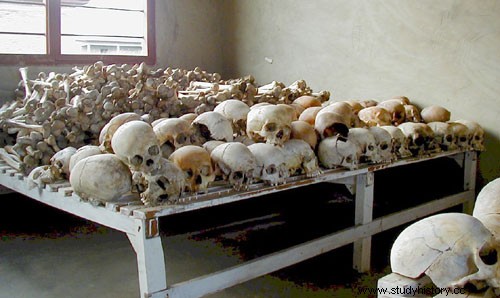- Rwanda and Burundi are two small African countries, smaller than Brittany, but twice as populated thanks to their exceptional fertility. Before colonization, different castes cohabited without being truly different ethnic groups. The distinction between these castes is made mainly by their role:the Tutsis are herders, and the Hutus are farmers.
- During Belgian colonization in 1924, a myth was created around the Tutsis, presented by the colonizers as superior to the Hutus. The Belgians therefore rely on the Tutsis to reign.
- In 1959 in Rwanda, tensions rose until they broke out in a Hutu revolution that claimed 10,000 lives, bringing about the end of Tutsi supremacy.
- In Burundi in 1972, the Hutus also tried to launch a revolution but without success:100,000 Hutus were massacred and the Tutsis retained power.
- The following year, in Rwanda, General Habyarimana's coup established a Hutu dictatorship, which was well received by part of the Tutsi aristocracy.
- In 1990, Paul Kagame, head of the Rwandan Patriotic Front (RPF), led mainly Tutsi soldiers from Uganda to regain power in Rwanda. In Kigali, the capital, Habyarimana took fright, but at the same time the French got involved in the conflict:paratroopers sent by François Mitterrand restored order for a while, while Habyarimana formed Hutu militias in each village. Social tension increases for four years.
- Under pressure from France, the Arusha Accords were signed on August 4, 1993. They provided for the restoration of peace by sharing power, but ultimately remained ineffective.
- In 1994, Tutsis represented 14% of the population of Rwanda and Hutus 85%.
April to July 1994

Characters
Juvenal Habyarimana
Paul Kagame
Francois Mitterrand
Procedure
On April 6, 1994, General Habyarimana's plane was shot down:in retaliation, the Hutus of the Habyarimana clan launched a machete massacre of Tutsis and moderate Hutus.
The country sinks into an extremely violent civil war from which no one escapes. The "castes" having mainly been created by the colonizers, it is difficult to distinguish who is Hutu or Tutsi:a climate of suspicion sets in.
Fighting between the Rwandan Armed Forces (FAR) and the Rwandan Patriotic Front (RPF) is raging across the country. France obtains authorization from the UN to launch Operation Turquoise, a military operation with humanitarian goals. The aim is to reinforce the safe humanitarian zone created on the border with Zaire. But it is a failure of France, since the massacres continue, even in the humanitarian zone.
On July 4, 1994, the RPF led by Paul Kagame seized power in Kigali, beginning bloody reprisals against the Hutus, who took refuge in Zaire.
Consequences
- With between 800,000 and 1 million dead, Hutus and Tutsis combined, the Rwandan genocide is one of only three recognized by the UN, and its horror has been widely publicized.
- Paul Kagame takes power in Rwanda, putting the country back under Tutsi domination:he enters the Commonwealth and moves away from “Françafrique”.
- The whole region is destabilized by the reversal of alliances and the migration of populations.
